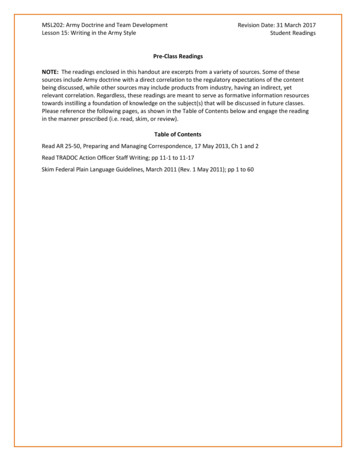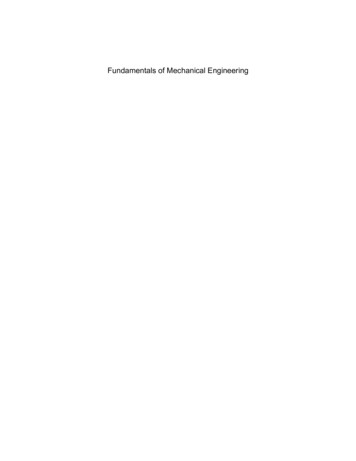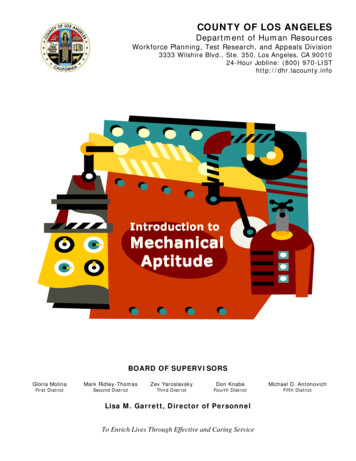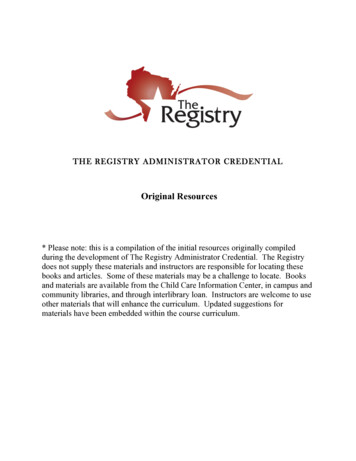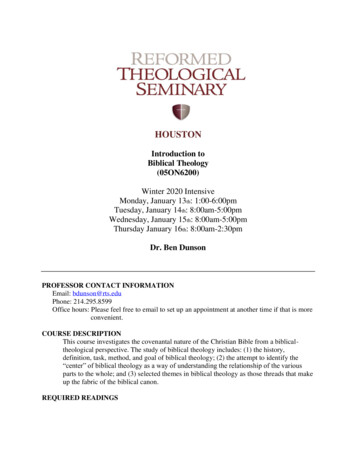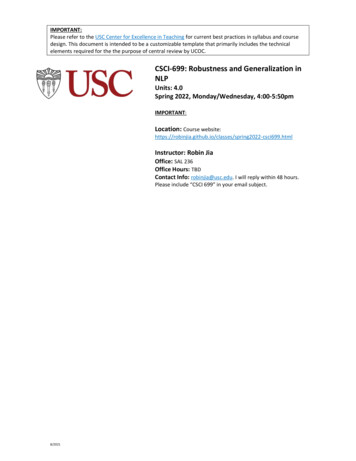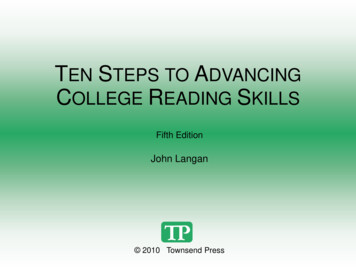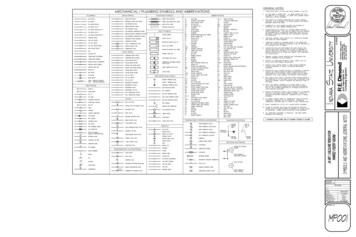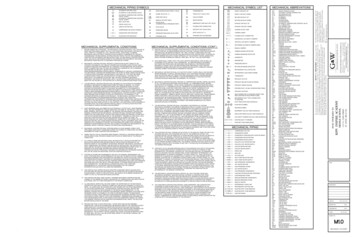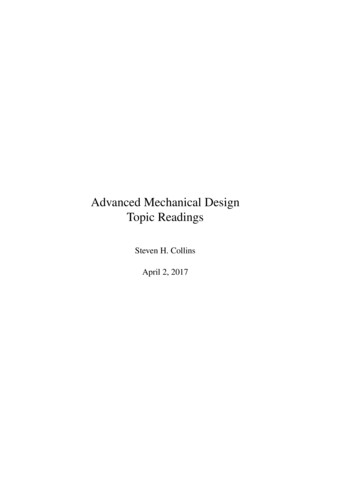
Transcription
Advanced Mechanical DesignTopic ReadingsSteven H. CollinsApril 2, 2017
Chapter 10Design for ManufactureAs we learned in the previous chapter, there are many processes available to economically manufacture large numbers of components. A good manufacturing process can be selected using charts, for example based on quantity, material selection, based on simplified models of loading and geometry, and cost comparisons,using an approximation of component geometry as a basis for calculations. Onceyou have selected a process, you can refine the details of your design to make itbetter suited to the chosen means of manufacture. First, your design will have toconform to the constraints of the process. For example, injection molded partscannot have features that that would prevent mold separation. Small changes toyour design can also dramatically improve the cost and quality of the parts produced. For example, tapering cast features allows flow of molten metal duringcooling to prevent voids. The process of optimizing a design in this way is calleddesign for manufacture. In this reading we will discuss design for two commonmanufacturing methods, injection molding and investment casting.10.1Injection Molding10.1.1ApplicationsInjection molding is often a good choice for manufacturing large quantities ofplastic parts. The initial costs of this operation are large but they allow a significantly lower variable costs once volume is above about 10,000 parts. The highinitial costs are incurred due to tooling (mold production). In recent years theintroduction of high-grade aluminum alloys has allowed for lower tooling costs.The introduction of these alloys allows smaller batches to be produced economically. Aluminum molds are easier to machine and therefore cost significantly lessto produce, but also have a shorter life span restricting viable quantities.2
10.1. INJECTION MOLDING3Figure 10.1: Injection Molding Setup (Xcentric Molds and Engineering).10.1.2ProcessInjection Molding is a process by which molten plastic is injected into a moldcavity using machinery specializing in pressurizing molten plastics. The set uprequires an injection press which consists of an injection unit and a clamping unit.These can be seen in Figure 10.1 with key components identified.The injection process begins with the insertion of a granular plastic into a hopper. This media is then pressurized by an injection ram or a screw type plungerand heated by a set of bands located along the length of the plunger (or ram). Asthe plastic melts it is forced through a nozzle that further increases the pressure.This nozzle leads to the mold and molding cavity. The mold is kept at a constanttemperature to ensure the plastic can travel far enough into the mold without solidifying, yet solidifies quickly once the cavity is filled. If the temperature of thecavity is too high the mold begins to see thermal stress and fatigue, lowering thelifespan of the mold. After the mold is filled, a constant pressure is maintained atthe nozzle to compensate for shrinkage as the plastic solidifies. Once the plastic isset, the mold is opened and the part is ejected. The ejected part will have a sprueand runners (Figure 10.2) which must be removed.10.1.3MaterialsMany polymers can be injection molded. An important property to consider iswhether the material is amorphous or crystalline. Amorphous materials tend tocontract less upon cooling, allowing tighter tolerances to be maintained, but havehigher viscosity, requiring higher pressure during injection and making it difficultto fill long thin mold cavities (Figure 10.3).
4CHAPTER 10. DESIGN FOR MANUFACTUREFigure 10.2: Injection molded parts just after ejection from the mold.Figure 10.3: Some materials used for injection molding and certain properties.
10.1. INJECTION MOLDING5Figure 10.4: Injection and ejector molds and components.10.1.4Mold FunctionMolds for injection molding primarily consist of two parts, the injection moldand the ejector mold (Figure 10.4). The injection nozzle connects to the injectionmold though a channel called a sprue. The sprue then then connects to channelsin the mold called runners that feed into the mold cavity. The runners lead to constrictions called gates, which lead into the cavity. Gates allow easier separation ofthe part from the runner following ejection. Air in the cavities is expelled throughvents in the parting line of the mold, which are too thin for plastic to enter. Failureto vent air can result in defects such as burning or voids.Molds are designed such that the injection-molded parts remain attached to theejector mold after mold separation. This attachment allows the runners and sprueto be drawn out of the injection mold leaving it clean to begin the process again.Once the part is secured on the ejector mold, ejector pins push the part out of themold and it is ready to start the process again.The injection, cooling and ejection processes, and the mold hardware used to perform them, tend to make some component properties desirable. In the next fewsubsections, we will discuss several heuristics for improving part quality and cost.10.1.5Draft AngleSurfaces of an injection-molded component that are parallel to the direction ofmotion of the mold are typically angled slightly to aid in the release of the part.This angle is called the draft angle. The degree of the draft depends on the depth
6CHAPTER 10. DESIGN FOR MANUFACTUREFigure 10.5: Draft angle examples (Not to scale; Mapeng).of the cavity and the amount of shrinkage of the part. For most applications adraft angle of 1–2 is effective. Figure 10.5 presents some simple examples ofdraft angles. Designs that lack draft angles can be damaged upon release from themold due to excessive friction. Parts lacking drafted features also have a higherprobability of becoming stuck in the ejector mold, causing delays to clean andpossibly repair the mold. Internal surfaces without a draft tend to be more of aproblem, because the plastic tends to contract as it cools. Contraction tends topull the part away from outer walls of the cavity and to bind it on inner surfaces.Additional mold features can aid with ejection of parts that require zero draftangles, but at increased cost.10.1.6Minimum Wall ThicknessWall thickness should be minimized for injection molded parts, within structuraland mold filling constraints. Reducing wall thickness reduces cooling time, whichin turn reduces time for molding cycles and allows for a higher production rate andlower part cost. Thinner parts also require less plastic, further reducing variablecosts. Wall thickness of an injection molded part can vary from about 0.020 inchesto 1 inch, with the viable range depending on material (Figure 10.9).10.1.7Uniform Wall ThicknessIdeally, injection molded parts have uniform wall thickness. If this is impractical,transitions in thickness should be as gradual as possible. Maintaining uniformthickness avoids issues related to uneven cooling. Thicker sections take longer tocool, which can lead to defects such as sink marks or warping (Figure 10.7).
10.1. INJECTION MOLDING7Figure 10.6: Recommended wall thickness ranges for different materials (Protomold). Thickness should be minimized for cost-optimal parts.Figure 10.7: Uneven wall thickness leads to uneven shrinkage which can causesinking, residual stress, voids or warping. Image from Plastics One.
8CHAPTER 10. DESIGN FOR MANUFACTUREFigure 10.8: Example of a component designed for lathe production and its coredcounterpart suitable for injection molding (ProtoLabs).Figure 10.9: Examples of boss strengthening (Stratasys Direct Manufacturing).10.1.8CoringOne way to maintain uniform wall thickness is to ’core’ thick sections. An example is shown in Figure 10.8. Proper coring tends to decrease strength only slightly.While complexity is increased, part cost and quality are usually improved overall.10.1.9BossesBosses are often used in injection molding to facilitate mating parts, attach fasteners or accept inserts. If a boss is not visible, its wall thickness can be kept atthe nominal thickness. If it is visible, it is recommended that 60% of the nominalthickness be used to reduce surface defects. In cases where a boss is isolated andrequires extra strength gussets or ribs may be used.
10.1. INJECTION MOLDING9Figure 10.10: Rib orientation should be chosen carefully to maximize strength forthe expected loading conditions (Stratasys Direct Manufacturing).Figure 10.11: Coring rib intersections reduces sink (Stratasys Direct Manu.).10.1.10RibsOne of the best ways to increase strength or stiffness in injection molded parts is toadd structural ribs. Ribs can cause defects, however, and the following guidelinesare intended to minimize negative effects. Rib thickness should generally be about60-80% of nominal wall thickness, and rib height should be limited to about threetimes the thickness. Separation between ribs should be at least two times nominalwall thickness. This allows for better temperature distributions during cooling.Of course, the location and orientation of ribs should be chosen so as to maximizestrength against expected loads (Figure 10.10)If ribs intersect, it recommended that a core hole be inserted at the intersection(Figure 10.11). This keeps the effective wall thickness more uniform, reducingthe likelihood of sinks.
10CHAPTER 10. DESIGN FOR MANUFACTUREFigure 10.12: Side action part and example of a functional alternative.10.1.11Side-Action MoldsParts with geometry that cannot be formed by two separable mold plates requirean additional molding plate and actuator, which greatly increases mold cost. Thethird mold section is inserted into one of the main mold plates and moves in andout from the side. After the cooling stage, but before the main molds separate,the side action mold is removed to allow ejection. The addition of side actionincreases both variable costs, because the duration of the operation is increased,and tooling costs, because of the mold and actuator complexity is increased.Side action is usually used to create undercuts or un-drafted sidewalls. For example, the part at the bottom of Figure 10.12 would require a side-action mold.Most likely, a straight pull mold would be used to create the overall shape andletter bosses, while a side pull would be used to create the hole for the hinge.Sometimes, side action can be avoided. An example of an alternative approach isshown at the top of Figure 10.12. In this case, similar functionality is providedusing telescoping shutoffs. In this shutoff approach, both sides of the main pullmold come into contact at the through hole. When using shutoffs it is recommended that a larger draft angle be used. Of course, this alters the appearance ofthe part, as well as its strength, and therefore may not be an effective workaroundin some situations.
10.2. INVESTMENT CASTING11Hardened SteelAluminumBeryllium-Copper233311113222Material CostMachinabilityThermal ConductivityHardnessTable 10.1: Mold material property ranking, where 1 is lowest and 3 is highest.10.1.12Mold Material Cost vs LifetimeTypical material choices for molds include hardened steel, aluminum and berylliumcopper alloys. The use of hardened steel allows for a large volume of productionwith minimal wear to the mold, but material and tooling cost are higher. Aluminum molds are typically used for smaller batch sizes since they are not as resistant to wear but have a much smaller cost in tooling and significantly better heatdissipation (Table 10.1).10.2Investment Casting10.2.1ApplicationsInvestment casting, also known as lost wax casting, has been used for thousandsof years, and technological advances in the past hundred years have allowed it toflourish. A wide variety of materials and shapes can be cast with this method,including metal forms unobtainable by die-casting, with a high degree of repeatability and robustness. In general, investment casting is more expensive per unitbut has lower equipment costs when compared to sand casting or die-casting. Itsmain advantage over other processes is the ability to create complex shapes withintight tolerances.10.2.2Investment Casting ProcessWax injectionThe investment begins with a sacrificial wax pattern that can be made using different molding processes. When creating this mold, shrinkage of wax and ceramicslurry must be taken into account and can sometimes require multiple trials to getfinal parts within tolerances. This is part of the reason these molds are expensive.
12CHAPTER 10. DESIGN FOR MANUFACTUREFigure 10.13: Wax pattern tree for investment casting.Figure 10.14: Ceramic coating on the wax pattern.Figure 10.15: Left: Pouring metal into the ceramic mold. Right: Knocking off theceramic leaves the castings and the sprue, which must then be cut off. Images arefrom the Library of Manufacturing.
10.2. INVESTMENT CASTING13AssemblyOnce a wax pattern is made, it is connected to a central wax component (sprue)along with other similar patterns to compose a casting cluster or tree (Figure 10.13).This wax structure will be lost (hence the name lost wax). A new wax positivemust be molded for every metal casting.Investment casting shellHaving the casting cluster completed, the wax is dipped in a ceramic slurry multiple times until there is a ceramic coat around the entire tree (Figure 10.14). Oncethe coating is thick enough it is left out in air to allow it to dry and harden. Oncethe ceramic coating is dry, the assembly is placed in an oven. The wax is firstmelted out, leaving the cavity into which the metal will be poured. Once the waxhas been removed, the oven is brought up to higher temperatures to strengthen theceramic and remove any leftover water or wax.Metal cast pouringThe mold is heated to a high temperature, to avoid thermal stress, and the moltenmetal alloy is poured into the ceramic and allowed to set.Knockout and cutoffOnce the metal has cooled the ceramic is chipped off. The final casting is cut fromthe sprue and additional operations, such as machining or grinding, are performed.10.2.3Draft AngleDraft angle for investment casting is not a requirement. Zero draft or negativedraft can be achieved with the initial wax shape, and therefore the final metal part,because of the way the wax shrinks as it cools.10.2.4ShapeInvestment casting offers flexibility in the shape of the final part because waxpositives can be easily molded and machined, and can be built up to complexshapes in multiple steps. However, some technique is required in order to retaintolerances and avoid defects, as explained in the following subsections.
14CHAPTER 10. DESIGN FOR MANUFACTUREFigure 10.16: Left: Molten material with no access to sprue will probably lead toa shrinkage void. Center: Tapering the feature protects the flow line at the corner,allowing flow from the sprue throughout solidification. Right: A sacrificial riserprovides liquid metal to feed the thinner part solidifying below, and takes the void.The riser is removed in post processing. Images from ESP International.10.2.5Material FlowMolten metal flows in from the gate at the sprue and works its way to all theextremities of the part. As the metal cools and becomes solid within the mold,it shrinks. If any pockets of molten metal become isolated from the gate, metalcannot flow into that pocket as it cools and shrinks. This leads to defects suchas voids, surface sinking and high residual stresses. It is therefore desirable toshape the part such that a single, continuous section of molten metal, connected tothe gate and sprue, will be maintained throughout the freezing process. Materialfreezes at the thinnest sections of the component first, and so good shapes for investment casting have their thickest features at the gate and their thinnest sectionsfarthest away from the gate. If a thin section separates two thick sections, it canfreeze first, leading to defects in the isolated thick feature. If such isolation cannotbe avoided, creating gradual transitions helps to mitigate the flaws.Flow considerations explain why the sprue tends to be large; the metal pool inthe sprue should be the last to harden as the casting cools, so that it can provide areservoir of liquid metal to feed the part as it shrinks. The sprue is recovered andmelted down for future castings to avoid waste.10.2.6Controlling Flow for ShrinkageVoids and residual stresses occur when there is not enough molten metal to feedthe space created by shrinkage. In most cases this happens when an internal areais molten and the path to the sprue has been cut off by solidified material (Figure 10.16). One way to reduce these defects is to add material to taper the feature,maintaining a continuous pool throughout freezing. Another method is to add ariser. Risers are thicker than the feature, holding molten metal longer and causingshrinkage effects to occur off of the part. Risers must be cut off after casting.
10.2. INVESTMENT CASTING15Figure 10.17: Wall junction design (ESP International). Junctions on the top rowhave relatively even wall thickness, which is preferable, while the junctions on thebottom row are uneven and more likely to lead to defects.10.2.7Fillets and JunctionsSharp corners can cause high residual stresses when cooling. Internal sharp corners can also cause ceramic slurry to overheat, creating a rough finish. Externalcorners can also cause fast cooling regions, leading to hardening similar to thatwhich occurs during heat treatment. Fillets mitigate these issues and help withmaterial flow around corners. At wall junctions, cutouts and rounding allow moreuniform wall thickness to be maintained (Figure 10.17).10.2.8Wall ThicknessWalls can be as thin as 0.030 inches, but the thinnest walls commonly producedare 0.060–0.090 inches thick, depending on feature surface area and alloy beingcast. Considerations for wall design are similar to other casting methods, in that itis desirable to maintain a similar wall thickness throughout the component. Ribsare often used to strengthen parts.10.2.9Aspect RatioIf a section of a component is long and thin, uneven cooling of the walls canlead to small pockets of liquid metal becoming trapped during freezing. In longthin features this can lead to warping, in addition to other defects. To avoid theseissues, a maximum aspect ratio of about 4:1 is typically recommended.
16CHAPTER 10. DESIGN FOR MANUFACTUREFigure 10.18: Standard linear tolerances for investment casting.Figure 10.19: Typical guidelines for maximum hole depth in investment cast parts.10.2.10Tolerance limitsLinear tolerances for cast features are provided in Table 10.18. Guidelines forother requirements, such as concentricity or straightness, can be found in referencetexts or online.10.2.11HolesSmall holes present a difficulty in investment casting because they may not becompletely filled with ceramic slurry during the coating process. For example, airbubbles can form within the hole in the wax positive and prevent penetration byslurry. The incomplete cylinder formed in the ceramic mold will allow metal topartially fill the part hole during casting. Similarly, it can become difficult to remove the ceramic from long, thin holes after casting. Maximum hole depth therefore depends on the hole diameter, whether the hole is through (easier) or blind(harder), the ceramic and the coating process involved. A typical set of guidelines
10.3. OTHER DETAILS AND PROCESSES17for maximum hole depth is provided in Table 10.19. Longer hole depths can beachieved using processes such as ‘ceramic coring’, in which a ceramic positive ismade separately and inserted into the ceramic negative, but at increased cost. Acounterbore or countersink can be incorporated easily.10.3Other Details and ProcessesSimilar guidelines for other features and for a wide variety of other manufacturing processes can be found in manufacturing textbooks, on manufacturer webpages and among other online resources. Many molding processes use similarprocedures and tools to the ones described here, which can help in identifyingthe ‘known unknowns’. For example, die casting utilizes similar molds as injection molding, with similar considerations of draft angle, coring, ribbing and pulls.Die casting also uses molten metals as with investment casting, with similar considerations for flow of material to freezing regions. When in doubt, search forguidelines that address your particular design situation.10.4AcknowledgmentsThanks to Roberto Jaime for help in drafting this chapter.
Apr 02, 2017 · 10.1. INJECTION MOLDING 3 Figure 10.1: Injection Molding Setup (Xcentric Molds and Engineering). 10.1.2 Process Injection Molding is a process by which molten plastic is injected into a mold cavity using machinery specializing in pressurizing molten plastics. The set up requires an injection press which

